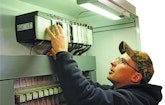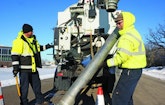
Interested in Trucks?
Get Trucks articles, news and videos right in your inbox! Sign up now.
Trucks + Get AlertsThe City of St. Cloud Department of Public Utilities got a wakeup call seven years ago.
“It all started with a very bad day back in 2008,” recalls Patrick Shea, director of Public Services. “We had a 6-foot main, installed in 1987, that totally collapsed. So we decided it might be a good idea to take a look at the rest of our pipes.”
Two other major interceptors had also collapsed in 2002 and 2006, but those failures involved old brick manholes that were already overdue for rehab. It was the collapse of the 21-year-old concrete main that really scared utility officials.
Most of the failures were due to excess retention times over their wide-spread system, especially at locations where steep drops created turbulence. Those conditions are conducive to growth of bacteria that lead to the production of sulfuric acid, which corrodes concrete pipes and manholes.
The Department of Public Utilities immediately launched an extensive inspection program. Utilizing outside contractors, they televised the entire system, feeding data and images into their GIS database. What they found was not good news. Much of their reinforced concrete pipe was showing significant signs of corrosion.
Phase IV details
Phase I was started in 2009, Phase II and III in 2010. This work used standard CIPP to rehabilitate the more accessible lines. Phase IV, started in 2011 and completed in 2014, used sliplining instead of CIPP. Those Phase IV pipes were the deepest, running under roads and buildings. Trenching would have caused significant disruptions.
“The choice of sliplining was based primarily on traffic and depth,” says infrastructure services supervisor Tim Hewett. “Some of those pipes ran under buildings at depths down to 25 feet. With the requirement for bypasses when doing CIPP, sliplining was just more cost-effective.”
Necessarily, sliplining reduces the cross-section available for flow, but with the pipe they used, capacity was actually increased. Flow had been around 1.2 to 1.7 fps, not quite fast enough to keep the solids moving all the time. The resultant high retention times increased the risk of corrosion. With the new pipe, flow rates are closer to the optimal 2.0 to 3.0 fps. That increase in capacity may seem counterintuitive, until you consider the fluid mechanics involved.
Special pipe
SCDPU chose a slip pipe made by HOBAS Pipe USA. That pipe is centrifugally cast, fiberglass reinforced, polymer mortar. The product is strong and light with uniform surfaces and high stiffness. It’s also inherently corrosion-resistant, with a design service life of up to 100 years or more. Wall thickness is only about 3/4 inches. But it was the extreme smoothness of the inside surface that caused the increase in capacity.
Smoothness of pipe interiors is measured by a number known as the Manning’s coefficient. It’s applicable to nonpressurized gravity-flow pipes and is a way to model the friction experienced by flowing fluids. Lower numbers are smoother, meaning less friction and faster flow. The HOBAS pipe comes in at 0.009, which is comparable to smooth brass.
By comparison, new concrete pipes rate around 0.011, but with significant corrosion can run as high as 0.020. Brick can go as high as 0.025.
“When we had good weather conditions we were able to push that pipe pretty quickly,” says Tracy Hodel, assistant director of Public Utilities. “Once, when we were on a roll, we pushed 25,000 feet in a single day. You don’t have all that wait time like with CIPP.”
Slip-pipe insertion was accomplished by a special machine, one of only two in the country: the Ackerman Hydraulic Pushing Machine. It was leased by their contractor for the job and has the capacity for long pushes, far exceeding that of a typical backhoe.
On other fronts
The pipe rehab involved during Phase I through IV kept SCDPU busy for close to six years. The majority of that work was contracted out, but there’s always something else that needs tending. In St. Cloud, a lot of that work comes from old infrastructure.
Inflow and infiltration was mainly from bad pipes, less so from manholes. But with 5,621 manholes in the system, the older ones made of brick, I&I and corrosion issues had to be addressed.
“We used spin-cast mortar to add strength to those old manholes,” Hewett says. “Then we applied an epoxy topcoat for corrosion resistance. That needs to be done on a properly prepared surface, to the right number of mils, or you won’t get a good seal against I&I. So there was a fair amount of prep involved.”
Freeze depth in winter shuts down all but necessary pipe work. By late winter, freeze depth averages 6 feet. Winter 2013 brought a 9-foot freeze depth. When you do have to trench in frozen ground, it involves an up-charge by the contractor. Freezing causes more urgent issues on the delivery side, with frozen and burst service lines and the occasional shallow main.
SCDPU’s 34 lift stations are holding up well. About half of them were installed between 1998 and present. A few have needed upgrades and a few more are in the queue for work, but they haven’t caused nearly as many problems as the RCP. “Overall, the pumps and other components have really held up,” Hewett says. “Many have already exceeded their expected lifetimes and are still within specs. You can thank maintenance for that.”
Lessons learned
SCDPU’s most recent effort focused on completion of their three-year Phase IV sliplining project, but they’ve had other work with unique challenges. Over the years, there’s been some major experience gained and some lessons learned.
“We’ve been working seriously on our I&I for close to 15 years, and the one thing we’ve really learned is the importance of inspection,” Hewett says. “And that’s not just the pipes — that includes the work done by contractors. There’ve been a couple of instances where we went in after the job, found faulty work and needed the contractors to do it over again.”
The utility now brings in NASSCO certified inspectors to vet all the outside work, especially with manhole rehabilitations. In a few cases, SCDPU has had to bring the contractor back multiple times to make it right. Investing in good inspections just makes sense, Hewett notes.
“Good inspections are important, and that’s also true for our preventive maintenance program,” Hewett says. “We like to stay on top of our system and anticipate future problems. We look 10, 15, 30 years ahead to be sure we’re ready.”









